If you’re one of the thousands of businesses out there that will redesign its website this year, you’ve probably got the same nagging thought in the back of your head.
This had better work.
It might be a twinge as you write a five-figure check to your web design agency.
Our new website better bring in more revenue.
It might be a pit in your stomach when you look at traffic numbers or conversion data.
The leads better start rolling in.
Heck, it might hit you when you’re tossing or turning at night.
A new website is a huge investment — in both time and money. You want to be sure that the investment is going to pay off.
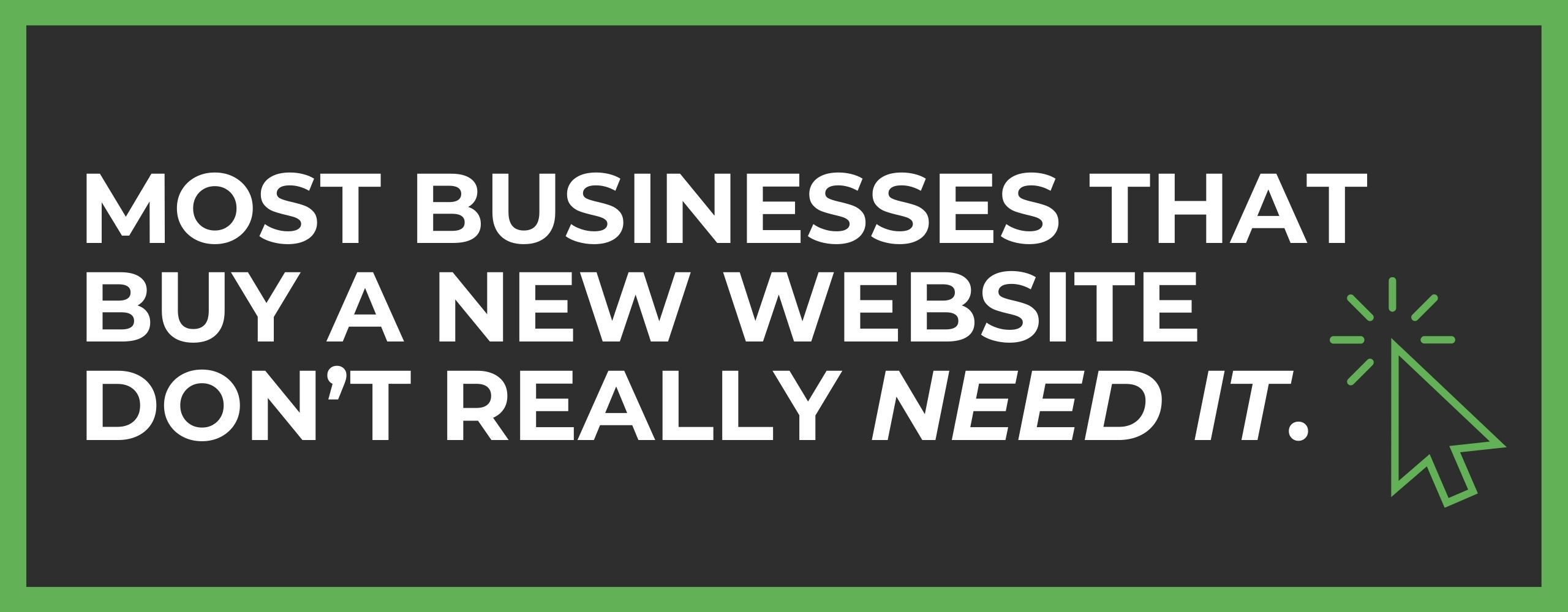
And here’s the sad truth of it all: Most businesses that buy a new website this year don’t really need it. They’ve been sold a “miracle cure” that’s not actually going to solve the problem they’re facing.
Of course there are times when a new website is needed — when it’s a really sound investment in the future of your business. And that’s what this article is going to do. To help you know when you do need a new website, and when you don’t.
Below, I’ll explain:
- Why a new website is often not the solution you’re looking for
- When you think you need a website but actually don’t
- When you actually should redesign your site
Before you spend big, let’s look at some hard truths together.
Hard truth No. 1: Agencies are happy to sell you a site you don’t need
Agencies are eager to sell you a fancy new website with all of the bells and whistles. Their job is to sell websites, and you’ve got money to spend. They’ll take your money and build you a website, whether you need it or not.
And they’re successful because businesses think a new website will solve all their problems.
When a business leader sees their traffic or their leads fall off, they think a new website will solve those problems.
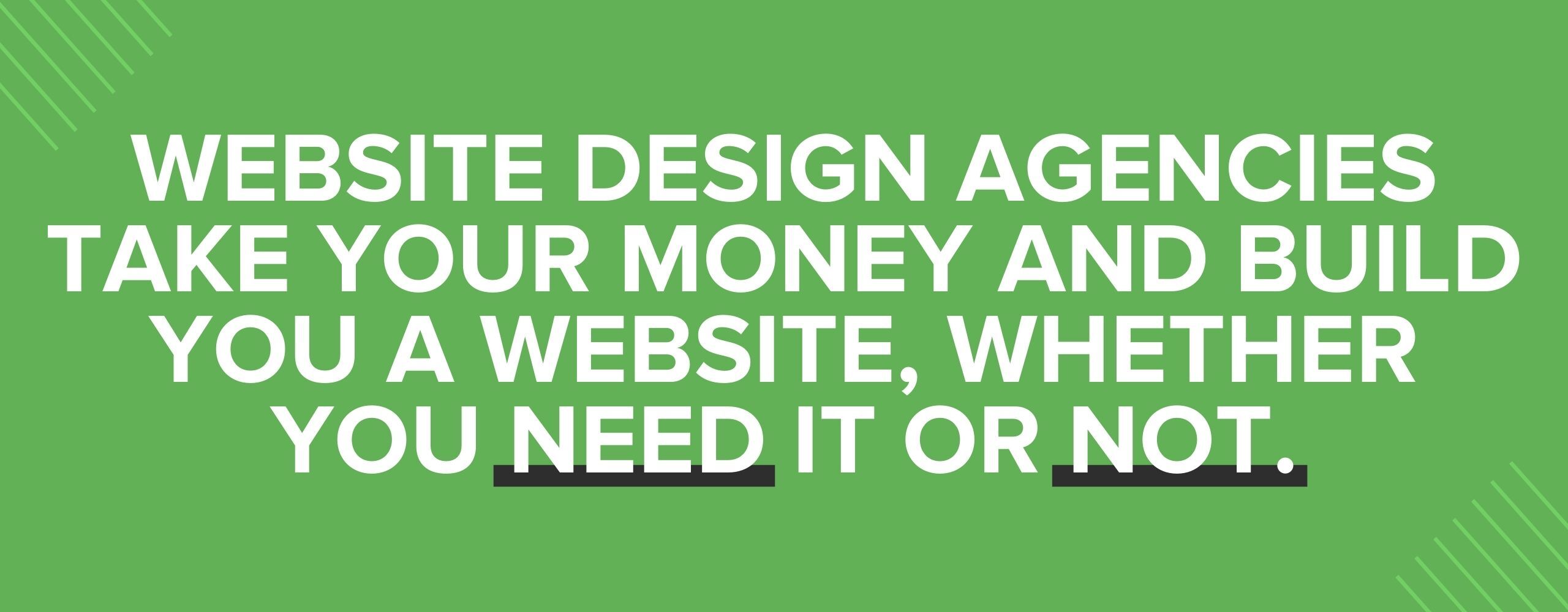
While I’m not saying a new website is necessarily a bad investment, it can be an expensive gamble. Websites often come in over budget and behind schedule — and they don’t always deliver a clear ROI.
Say you spend $75K on a new site that takes nine months to launch. How can you be sure that it will be worth the investment?
If you’re not connecting that website to a strategy, you can’t.
Hard truth No. 2: A website is not a marketing or sales strategy
You think you need a new website because you need more leads and more revenue, but what about the new site is actually going to do this?
Or, put it this way: What’s going to make prospects find your shiny new website?
- Are they coming to you through organic search or social? Then you need a robust content strategy to produce and publish the content that will rank in search results at a consistent rate, all while being valuable to visitors.
- Are these prospects coming through PPC? Then you need dedicated, effective landing pages and conversion paths that will speak to their challenges and present your solutions.
In any case, you need a strategy for how you (and your customers) will use this new website — and any agency not talking about strategy is unlikely to deliver the site you need.
Now, most agencies do talk about strategy, but they’re talking about a website strategy — that is, page layout and UX, not a marketing, sales, or business strategy.
When you think you need a new website (but you actually don’t)
Despite what you’ve been told, most website issues can be solved without a full redesign. 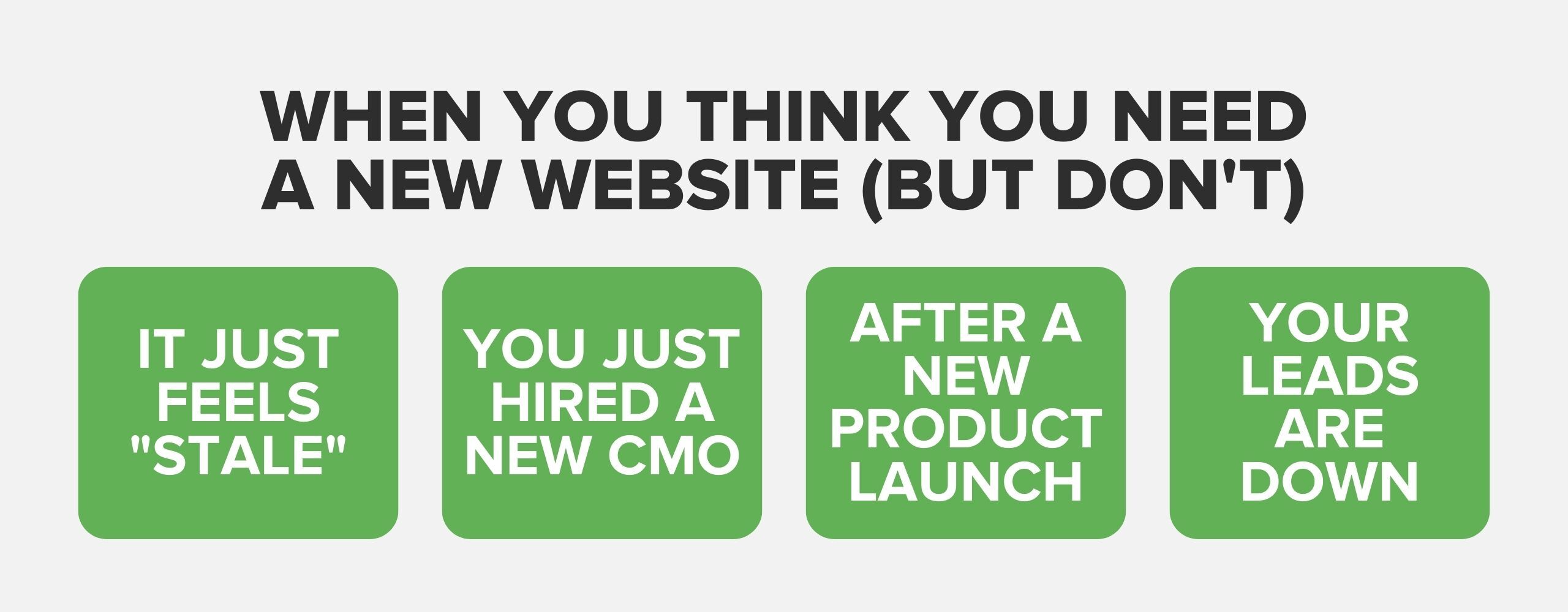 If you’re facing one of these challenges, don’t spring for a new website just yet.
If you’re facing one of these challenges, don’t spring for a new website just yet.
‘Our site just feels stale’
If what you’re facing is an aesthetic challenge, you could opt to update the styles of the current website instead of doing a full website redesign. You’ll pay about 80% less and can potentially be done in weeks instead of months.
‘We just hired a new CMO’
A new marketing leader often wants to shake things up and a new website might be first on the list.
However, a new website by itself is not going to fix whatever issues you’ve faced in the past. Pump the brakes and look at some numbers before you give your new CMO a blank check.
‘We’ve just launched a new product’
Good for you. That’s exciting. Do you need a whole new website to support this launch? Almost certainly not.
If you need help, an agency can build new pages without designing and developing a whole new site. (And with a bit of training, you could even do it yourself.)
‘Our leads are down’
I get it. It’s stressful when your lead pipeline shrinks, but unless you’re addressing your underlying marketing strategy, a new website is unlikely to solve the problem in and of itself.
When you DO need a new website
Now let’s look at the other side of things. When is the right time to redesign your site?
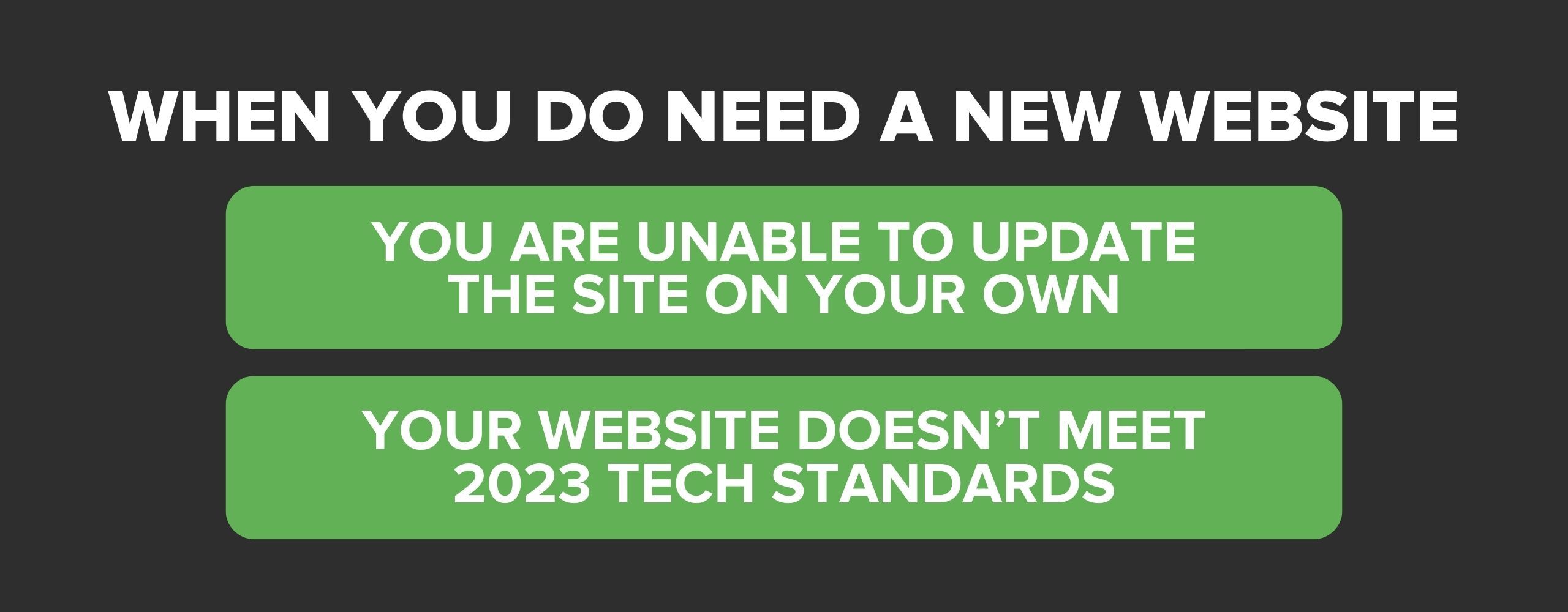 Having worked with hundreds of businesses over the years, I believe there are only two situations when you absolutely need to update your site.
Having worked with hundreds of businesses over the years, I believe there are only two situations when you absolutely need to update your site.
‘We are unable to update the site on our own’
This is the biggest one. If your business can’t update its own site without contacting an agency or hiring a freelancer, it’s time for a new site.
The way modern sites are built, your team should be able to do everything from building landing pages to updating product listings without needing to code.
An outdated website is a liability that makes your business look bad.
Whatever you do, don’t work with any agency that tells you they can’t build you a site you can update on your own. This is a major red flag that’s designed to keep you from being independent.
‘Our website doesn’t meet 2023 tech standards’
This has nothing to do with graphics or user experience. Nothing to do with stock images or page layout. Instead, we’re talking about Core Web Vitals, such as site speed, mobile responsiveness, and page scripts.
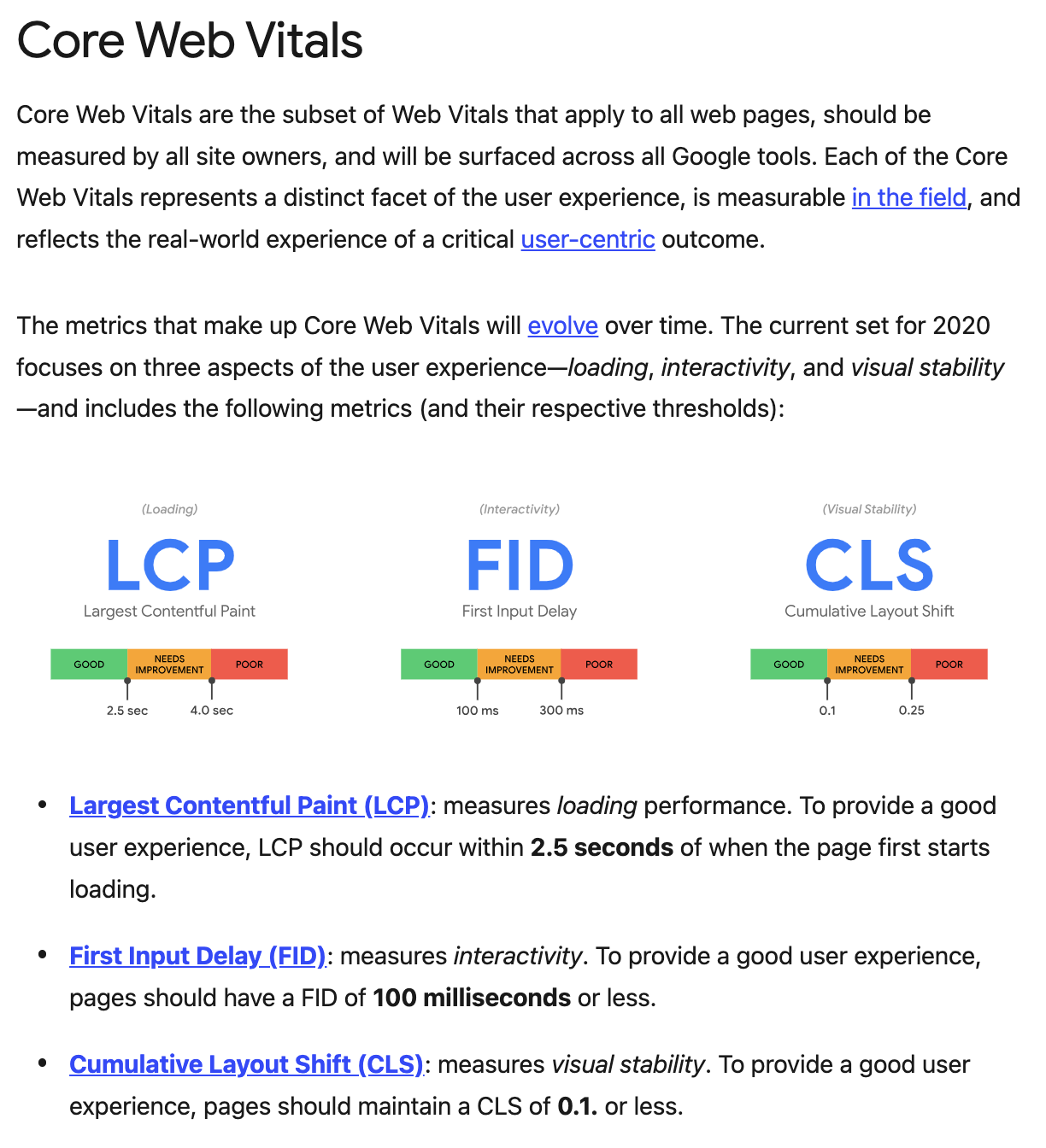
(Source: Google)
If your site doesn’t meet the modern standards established by the search engines, it’ll be hard to rank well in them, and it’s time for a new site.
If your website is unable to deliver in these fundamental ways, new images and designs won’t save it. Your indexed pages will continually slip in search rankings, and your traffic will dwindle.
You need a site that meets up-to-date thresholds for performance.
Before you invest in a new site, consider your strategy
Optimizing your existing site should be your priority before considering a new website. Here are essential steps to take:
- Conduct a UX Audit: Use tools like Lucky Orange or Hotjar to analyze user behavior, heatmaps, and click patterns. Identify pain points and areas for improvement in the user experience.
- Run Experiments: Based on what you see in your UX audits, you’ll notice what users do (and don’t) engage with. For example, if a primary call-to-action gets no engagement, run an A/B test to see if more specific language can improve engagement.
- Build a Content Strategy: Develop a comprehensive plan for creating helpful and engaging content. Conduct keyword research, create a content calendar, and diversify your content formats.
- Track and Analyze Performance: Implement a robust analytics platform like Google Analytics 4 (GA4). Monitor metrics such as traffic sources, organic traffic changes over time, bounce rates, and conversion rates. Make data-driven decisions based on insights gained.
- Optimize for Search Engines: Incorporate relevant keywords in titles, descriptions, headers, and content. Pay attention to on-page factors like URL structure, internal linking, and image alt text. Improve site loading speed, mobile responsiveness, and technical performance.
If you follow all of those best practices, you will almost certainly notice improvements in your website’s performance. And if you do need a new website, you’ll be armed with the knowledge you’ll need to make it as effective as possible.
Get the site you need
A website is a big purchase — and the process is both exciting and stressful. If you think you’re in the market for a redesign for your custom site, do your research. Don’t just talk to agencies that are jumping to sell you the thing you’re still deciding if you need.
We work with businesses every day who come to us after dropping a ton of budget into a new website. Instead of being the salvation they were hoping for, the website fails to deliver results. Their numbers stay flat, and they’re left scratching their heads as to why it didn’t work.
Avoid their costly mistakes.
Ask the right questions so you know you’re getting the site you need.
And if you’re not sure what you need, start with our free website performance assessment. You’ll get the insights you’ve been looking for.



